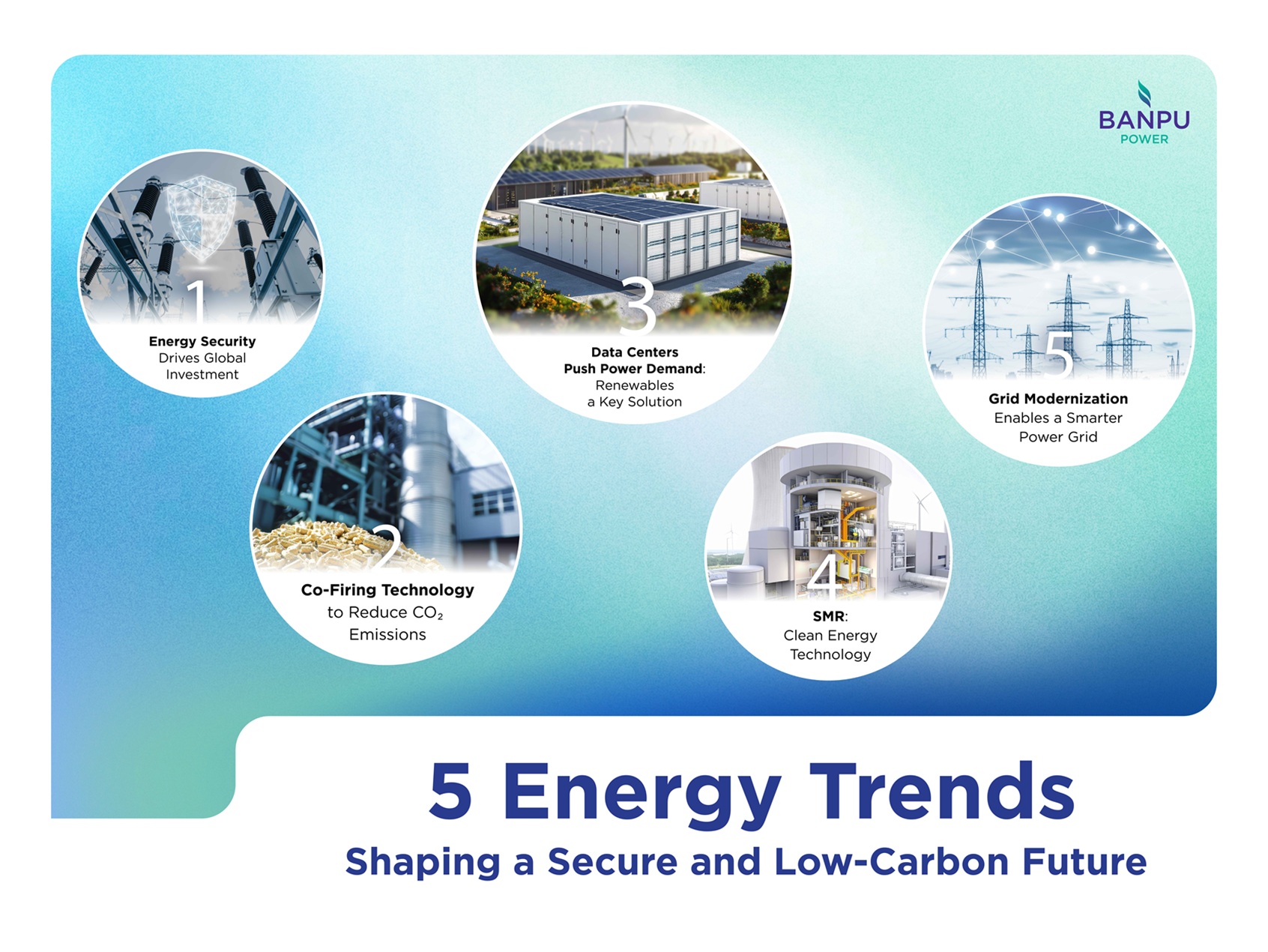BPP Reveals 5 Energy Trends Shaping a Secure and Low-Carbon Future

As global energy systems face unprecedented challenges, electricity demand is soaring due to multiple factors: persistently rising temperatures, the shift toward electrification, and the digitalization of daily life driven by interconnected technologies. Simultaneously, geopolitical tensions and environmental pressures are accelerating the global push for secure and sustainable energy systems. Energy technologies and innovations are playing an increasingly critical role in transforming how energy is generated and consumed, enhancing efficiency and flexibility while advancing energy security and decarbonization. In response to the evolving energy landscape, Banpu Power PCL (BPP), an international energy producer company, has identified five major energy trends that businesses should closely track to stay ahead.
- Energy Security: A Key Driver of Global Investment
According to the latest report by the International Energy Agency (IEA), energy security has emerged as a primary driver behind global energy investments, which are projected to reach USD 3.3 trillion in 2025. Of this, USD 1.1 trillion will be allocated to fossil fuels—including oil, natural gas, and coal—while USD 2.2 trillion is earmarked for clean energy technologies such as renewables, nuclear, electricity grids, and batteries.[1] With electricity demand climbing steadily and growing concerns about energy stability, governments and businesses worldwide are actively balancing investments in both conventional and clean energy sources. The goal is to ensure an uninterrupted and sustainable power supply that meets domestic demand, while also strengthening long-term business resilience and national economic security.
- Co-Firing Technology: A Pathway to Reducing CO₂ Emissions
Thermal power plants remain a critical component of electricity generation, ensuring a steady supply for households and economic activities. Co-firing technology blends alternative fuels such as biomass, hydrogen, or ammonia with fossil fuels in power plants. It is gaining traction as a practical method for reducing CO₂ emissions. Several countries have already rolled out concrete plans. For example, China requires that all upgraded or newly built coal-fired power plants be capable of co-firing at least 10% biomass or ammonia[2] by 2027, aiming to halve CO₂ emissions by 50% compared to 2023 levels under its “Low-Carbon Transformation of Coal Power Plants” plan (2024–2027).[3] In Thailand, the latest “Power Development Plan” (PDP 2024) outlines a roadmap for blending 5% hydrogen into natural gas for power generation between 2030 and 2037.[4] Co-firing is transforming conventional thermal power plants to become more environmentally sustainable.
- Data Center Boom Pushes Power Demand; Renewables Emerge as a Key Solution
Renewable energy is seeing sustained growth as it responds to surging electricity demand driven by the digital economy and the expansion of data centers. According to the IEA, electricity consumption from data centers is expected to more than double by 2030, reaching approximately 945 terawatt-hours.[5] Tech giants like Amazon Web Services have committed to powering their data centers with 100% renewable energy by 2025[6], while Microsoft and Google Cloud have gone further with pledges to achieve 24/7 carbon-free energy (CFE) by 2030.[7] However, thermal power remains critical for maintaining grid stability, particularly during periods when renewable generation is intermittent. Research by Precedence Research projects that the global thermal power market will grow from USD 1.56 trillion in 2025 to USD 2.13 trillion by 2034.[8] This also includes technologies such as Battery Energy Storage Systems (BESS), which store electricity and dispatch it back to the grid when renewables are not generating power, helping to manage electricity demand more effectively. The BESS market in Asia-Pacific is projected to reach USD 14.67 billion by 2033.[9] This underscores that the energy transition will continue to rely on a balanced mix of thermal power, renewables, and energy technologies to ensure grid resilience and flexibility.
- Small Modular Reactor (SMR): Clean Energy Technology
A small modular reactor (SMR) is a clean-energy power plant that harnesses nuclear fission to generate electricity. A key advantage lies in its efficient management of spent radioactive materials and a design that enhances nuclear safety through advanced cooling systems to maintain optimal operating temperatures. Designed as compact modules with capacities of up to 300 megawatts (MW), SMRs can be constructed and deployed more quickly than traditional nuclear plants—typically within 3–4 years compared to 5–6 years for conventional facilities. They deliver continuous, CO₂-free power with enhanced generation resilience. Several countries are making significant strides. China is developing the ACP100 “Linglong One,” situated in Hainan province, with a capacity of 125 MW and is expected to begin operations in 2026.[10] In the United States, the 77-MW NuScale Power SMR design has already received regulatory approval.[11] In Thailand, the draft Power Development Plan 2024 (PDP 2024) includes plans for two 300-MW SMRs, with work underway to build the necessary infrastructure to support future deployment.[12] SMRs represent a promising pathway toward strengthening energy security and reducing carbon emissions over the long term.
- Grid Modernization: Upgrading the Power Grid to Be Smarter and More Advanced
Grid modernization involves upgrading electrical infrastructure to become smarter, more resilient, and more efficient, enabling it to handle diverse energy sources, including renewables, and meet future energy needs. Infrastructure improvements and the integration of digital technologies, such as automation systems, data analytics, and real-time load management, are central to reducing CO₂ emissions and maintaining system stability.[13] In the Asia-Pacific region, the grid modernization market is projected to grow from USD 12.7 billion in 2024 to over USD 51.5 billion by 2032.[14] The United States is advancing its ‘Grid Resilience and Innovation Partnerships’ (GRIP) program with a USD 10.5 billion budget to strengthen grid resilience against climate volatility.[15] Meanwhile, China plans to invest USD 800 billion in grid upgrades by 2030 to meet rising electricity demand and support its energy transition.[16]
Looking ahead, energy systems worldwide are being shaped by technology and innovation to deliver secure, flexible, and low carbon energy solutions. This shift is no longer a distant policy aspiration but a reality unfolding across industries globally. As an energy leader operating in eight countries, BPP remains committed to producing high-quality, environmentally friendly power while advancing decarbonization. The company’s mission is to strengthen energy security and support sustainable growth in every market where it operates.
Learn more about BPP’s business at www.banpupower.com.
[1] Source: Energy Connects – Global energy investment to cross $3.3 trillion in 2025 amid energy security concerns
[2] Source: China Coal Action Plan Offers Roadmap for Coal Phase-Out, Asia Research and Engagement
[3] Source: Ammonia Energy – China: renewable ammonia to reduce power generation emissions
[4] Source: Thai PBS – PDP ฉบับใหม่เริ่มใช้ พลังงานไฮโดรเจนในปี 2030
[5] Source: Energy and AI, International Energy Agency (IEA)
[6] Source: Cedara – Tracking the Transition to Renewable Energy Across Data Centers
[7] Source: Eurelectric – Exploring the 24/7 carbon-free energy (CFE) ecosystem – the future of corporate procurement
[8] Source: Precedence Research – Thermal Power Plant Market Size, Share and Trends 2025 to 2034
[9] Source: Globe News Wire – Asia-Pacific’s Liquid Cooling Market for Stationary Battery Energy Storage Systems (BESS) 2025-2033: Analysis of Trends, Supply Chain, R&D, Regulations, Investment & Funding, Case Studies and More
[10] Source: Energy News – ACP100, China’s first modular reactor for sustainable nuclear energy
[11] Source: Reuters – US approves NuScale’s bigger nuclear reactor design
[12] Source: กรุงเทพธุรกิจ – ผ่าแผนลงทุนโรงไฟฟ้า SMR โจทย์ร้อนนำร่องนิวเคลียร์ขนาดเล็ก 600 เมก
[13] Source: Sustainability Directory – What Is Grid Modernization?
[14] Source: Credence Research – Asia Pacific Grid Modernization Market
[15] Source: U.S. Department of Energy – Grid Resilience and Innovation Partnerships (GRIP) Program
[16] Source: Climate Insider – China Plans to Invest $800 Billion in Creaking Electricity Grid to Accelerate the Green Transition
###
About BPP
Banpu Power Public Company Limited (BPP) is a leading international energy producer company committed to delivering reliable energy, enhancing quality of life, and advancing environmental sustainability. BPP operates across thermal energy and Renewables+ portfolio, which includes renewable energy and other energy-related business, in eight strategic markets: Thailand, Laos, China, Japan, Vietnam, Indonesia, Australia, and the United States.
For nearly three decades, BPP has generated and delivered high-quality power solutions through advanced technologies and strong corporate governance. The company is dedicated to building a sustainable future by supporting local communities and aligning its operations with environmental goals in every country where it operates.



